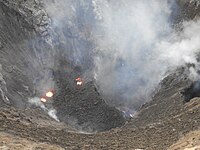
Photo from wikipedia
Abstract To reduce the flow energy of rockfall in rmountain area, a baffle array is set up in the protection zone. The optimized design can enhance the efficiency of hazard… Click to show full abstract
Abstract To reduce the flow energy of rockfall in rmountain area, a baffle array is set up in the protection zone. The optimized design can enhance the efficiency of hazard source energy dissipation project. In the present study, the arc-shaped baffles were studied as compared with the conventional baffles (square baffles and cylindrical baffles) based on practical engineering. The comparison of three types of baffles was discussed in detail by experimental studies, which primarily focused on the blocking ability and effectivity. In particular, by determining the optimal case using those different types of baffles, the effects of the optimization of baffle system [column spacing, row spacing and Ld (distance between first baffle row and chute terminal)] were investigated. According to the results, the arc-shaped baffle is the best case among those three types of baffle, i.e. the deposit area and runout are all shorter than those of any other cases with the same value of Sr. Shape changing (cylindrical to arc-shaped) will up-regulate the fragment blockage degree; the following avalanches will take place close to the avalanche deposition, leading to a huge dissipation of kinetic energy. Moreover, by comparing deposition, dimensionless velocity (U*) and velocity reduction ratio (VRR), arc-shaped baffle system showed competitive blocking ability when Sc = 3.5 and Sr = 4.5. With the rise in the Ld, the energy dissipation efficiency can be enhanced through the particle collision and particle friction during the geo-disaster movement. Furthermore, it can effectively narrow the deposit area and reduce deposit depth and deposit width. The results obtained from this study are useful for facilitating design of baffles against rock avalanches.
Journal Title: Engineering Geology
Year Published: 2020
Link to full text (if available)
Share on Social Media: Sign Up to like & get
recommendations!